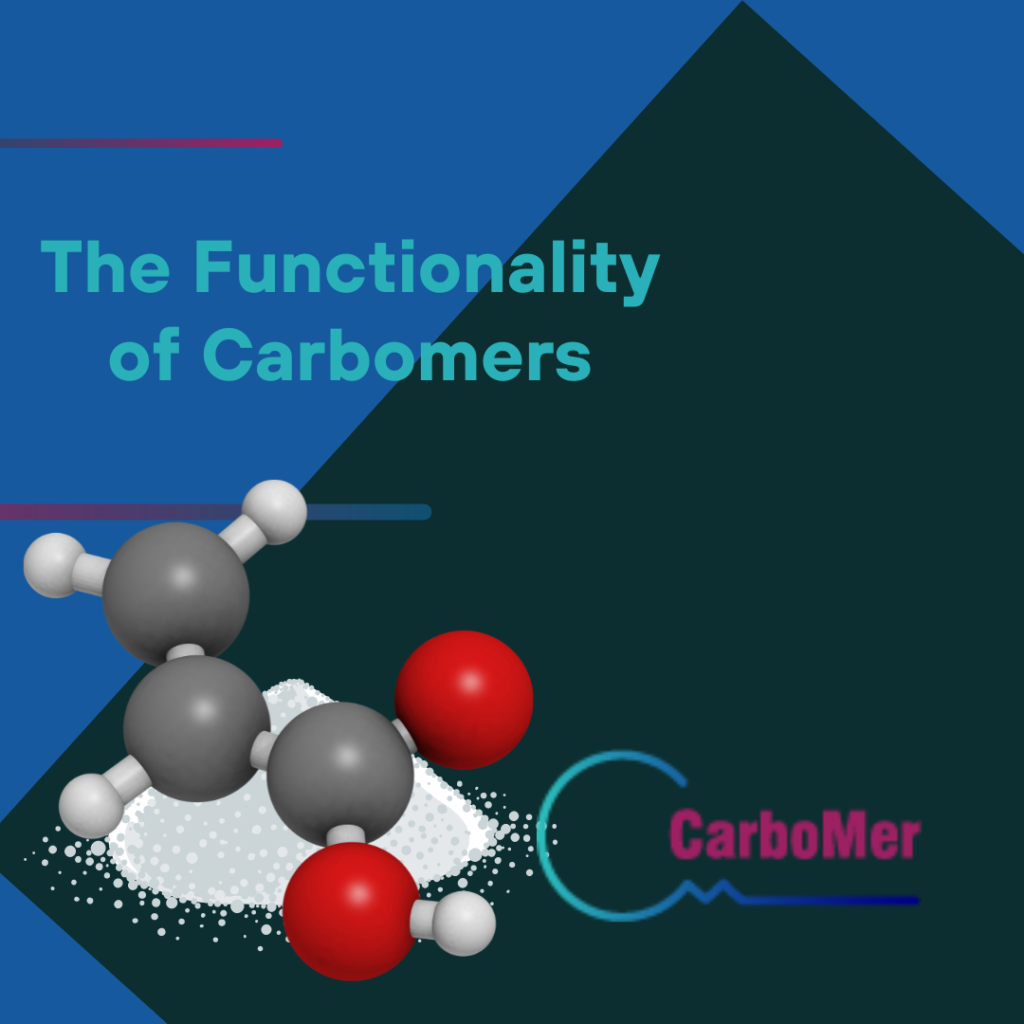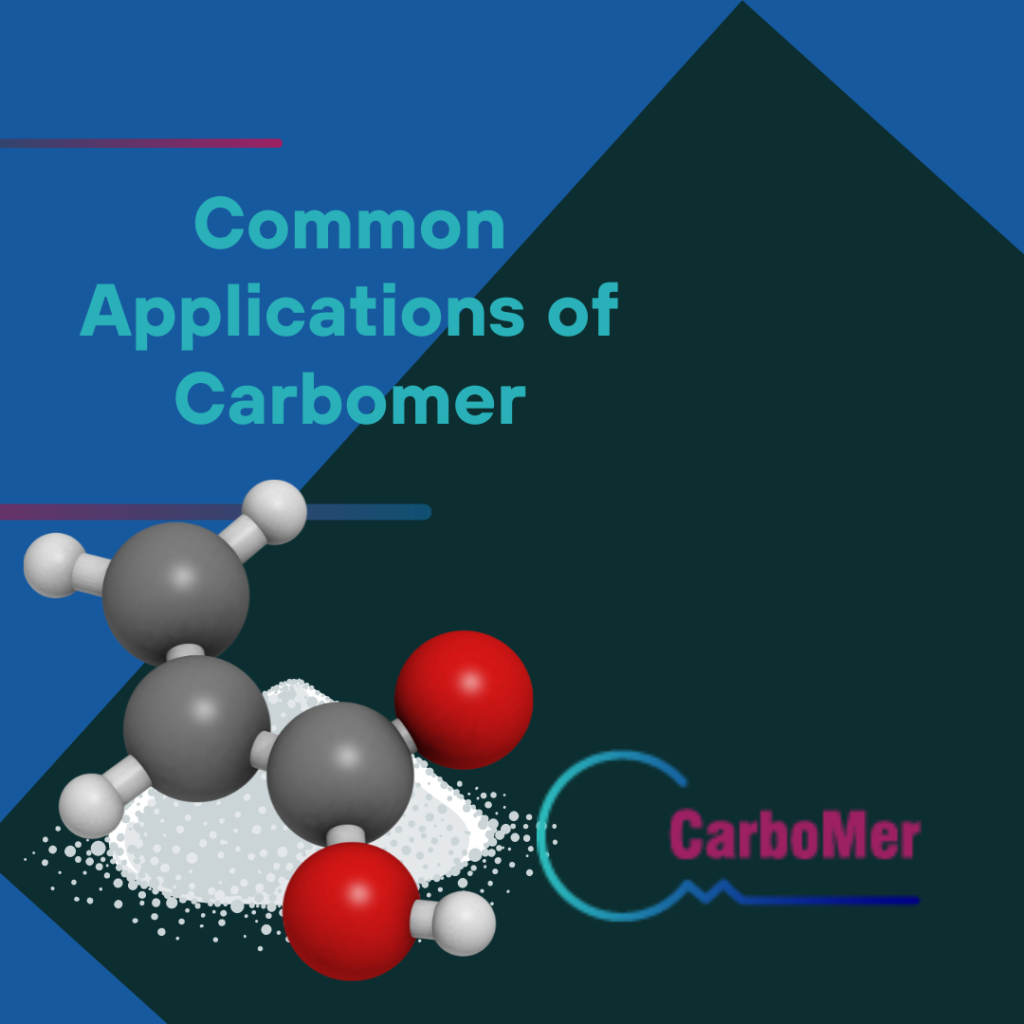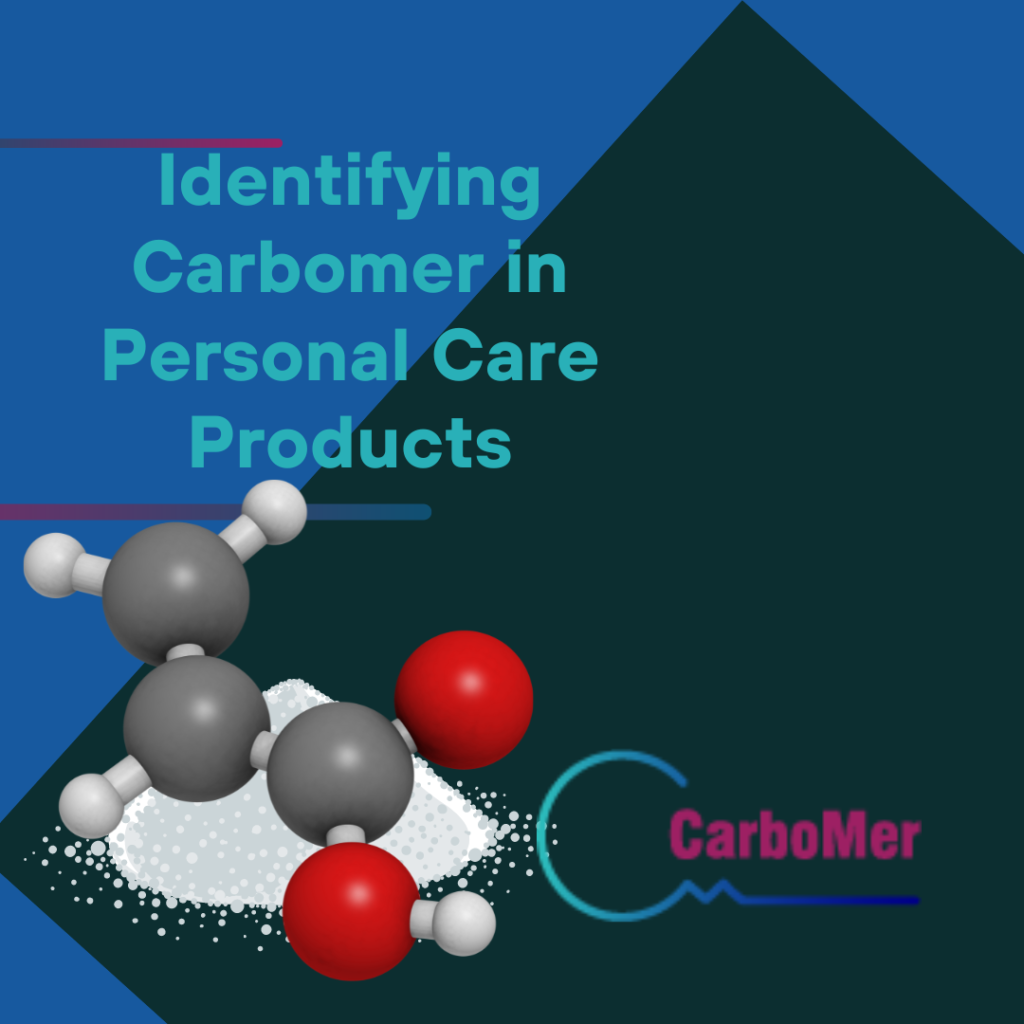Carbomer is a key ingredient in many personal care products, serving as a thickener and stabilizer to enhance the texture of creams, gels, and lotions. In this guide, we dive into the specifics of “what is Carbomer”, its crucial role in cosmetic formulations, and what you can expect from its use without any fluffy add-ons or sales pitches.
Key Takeaways
- Carbomer is an essential synthetic polymer used in personal care products for its thickening, suspending, and emulsion-stabilizing properties, transforming product consistency and enhancing consumer experience.
- The safety of Carbomer has been affirmed by regulatory agencies like the FDA, although caution is advised due to potential skin irritation or allergic reactions in sensitive individuals.
- The push for sustainability in the personal care industry has led to the exploration of eco-friendly alternatives to Carbomer, such as natural thickeners and cellulose derivatives, to minimize environmental impact.

Understanding Carbomer: Definition and Properties
Carbomer is not just a component; it’s a cornerstone in the formulation of personal care products. This synthetic polymer’s claim to fame is its phenomenal thickening, suspending, and emulsion-stabilizing properties. Think of it as the architect of product consistency, crafting the ideal viscosity and feel that consumers adore.
But what exactly is this ingredient, and how does it achieve such feats? Let’s delve into the science behind Carbomer, exploring its definition, structure, and the unique characteristics that make it indispensable in the realm of personal care.
Chemical Structure and Composition
Diving into the molecular world, Carbomers are composed of acrylic acid monomers linked by carboxylic acid groups, forming long, winding polymer chains. These structures are not just strings of chemical jargon but the very blueprints of Carbomer’s functionality.
Take Carbomer 941 for instance, with a molecular weight signaling its significant presence. It’s the ionizable carboxylic groups within that are the true heroes, absorbing water and causing the polymer to swell, giving rise to its impressive thickening capability.
Physical Characteristics
Carbomers are more than just ingredients; they are the alchemists of personal care, turning liquids into luxurious gels and creams. In their raw form, they appear as fluffy white powders, tiny particles that hold the potential to revolutionize a product’s texture. When they encounter water, a dramatic transformation occurs – they swell, not dissolve, forming microgels that contribute to a gel-like consistency and increase viscosity up to 1000 times their original value.
This ability to retain water and create uniform dispersions makes Carbomers a favorite among formulators aiming to achieve the desired consistency, whether it be for the skin or within aqueous solution phases of a product.

The Functionality of Carbomers in Personal Care Products
Carbomers are the unsung heroes in the personal care narrative, improving the texture, viscosity, and stability of an array of products. These synthetic polymers ensure that our lotions are luxuriously thick, our gels are perfectly sculpted, and our emulsions remain harmoniously blended. Carbomers not only contribute to the sensory appeal but also to the efficacy and longevity of cosmetics and personal care items.
They are the invisible threads that hold together the intricate tapestry of personal care products, making them an essential ingredient in the industry.
Thickening and Gelling Agent
Carbomers are the artisans of the personal care world, meticulously crafting the gel-like consistency that is both aesthetically pleasing and functionally effective. As thickening agents, they are versatile, creating textures ranging from light lotions to heavy creams, satisfying every consumer’s tactile preference. Additionally, Carbomers can be considered as gelling agents, further enhancing their role in the personal care industry.
These high molecular weight polymers can form gels that are clear, lending an elegant transparency to products like serums and hair styling aids. However, the addition of salts must be carefully considered, as they can reduce the viscosity-building effect, a testament to the delicate balance required in formulating with Carbomers.
Suspending Agent
Imagine a snow globe where the glitter remains evenly dispersed long after it’s been shaken. That’s the visual effect Carbomers have as suspending agents in personal care formulations. They are the guardians of consistency, ensuring that every dollop of cream or squirt of shampoo delivers the same concentration of active ingredients and sensory attributes.
By providing viscosity control, Carbomers help maintain the uniformity of the product, keeping ingredients like microbeads or pearlescent particles suspended, not sinking to the bottom or floating to the top.
Emulsifying Agent
Emulsions might be delicate concoctions, but Carbomers are the stabilizing force that keeps them intact. By acting as emulsifying agents, they prevent the dreaded separation of oil and liquid parts, ensuring that each application is as good as the first. This is particularly important in products like hand sanitizers, where Carbomers help to keep active ingredients well-mixed and effective over time.
The result? Products that are smooth, homogeneous, and reliable – hallmarks of quality in the personal care industry.

Common Applications of Carbomer in Personal Care
Carbomer’s versatility shines across a spectrum of personal care products, including Carbomer containing product options, from the night cream that soothes your skin to the mascara that defines your lashes. Its role in improving texture and maintaining stability is evident in skincare formulations, enhancing the sensory experience and visual appeal of the products we use daily.
The impact of Carbomer extends to lotions, creams, gels, and more, making it a ubiquitous presence in our personal care rituals.
Skincare Products
When it comes to skincare, Carbomer is the maestro of moisture, guiding products to their perfect pitch of plush and pampering textures. It is instrumental in creating the creamy consistency that makes creams and lotions a delight to apply, ensuring a smooth, even distribution on the skin. The versatility of Carbomer also extends to other skincare essentials like:
- Foaming cleansers
- Serums
- Sunscreens
- Acne treatments
Each benefiting from its texture-improving prowess.
Cosmetic Products
In the realm of cosmetics, Carbomer is a key ingredient behind the seamless application and lasting performance of makeup products. It allows foundations to glide on effortlessly, providing the ideal stickiness for a flawless finish. Carbomers also enhance the texture of concealers for a smooth complexion.
They also improve the mascara application, ensuring lashes are coated evenly without clumps.
Pharmaceutical Formulations
Beyond the beauty aisle, Carbomer’s influence extends into the pharmaceutical domain. In oral care products like toothpaste and mouthwashes, Carbomer ensures texture consistency and suspends insoluble particles, contributing to the overall efficacy. In medicinal suspensions, Carbomer acts as a rheology modifier, controlling viscosity for a controlled release of medication – a critical factor in the effectiveness of these formulations.

Safety and Side Effects of Carbomer
Despite Carbomer’s widespread use, questions about its safety and side effects linger in consumers’ minds. Fortunately, Carbomer is generally regarded as safe, with no links to serious health concerns like cancer or reproductive toxicity. However, it is essential to note that Carbomers come with a set of precautionary measures due to their corrosive nature, which calls for careful handling and usage.
The potential for skin irritation or allergic reactions, particularly in sensitive individuals, underscores the importance of patch testing before embracing products containing Carbomers.
Regulatory Approval and General Safety
When it comes to regulatory oversight, Carbomers have passed the scrutiny of agencies like the FDA, ensuring consumers can use Carbomer-containing products with confidence. The substance is governed by specific regulations and is categorized under various classes to address the different types of Carbomers used in cosmetics, attesting to its safety and reliability in personal care.
Potential Risks and Allergenicity
While Carbomers are generally non-irritating, they are not completely exempt from causing adverse reactions. A subset of consumers may experience skin irritation or allergic reactions, making a preliminary patch test a wise precaution. These reactions can often be attributed to neutralizing agents like sodium hydroxide used with Carbomers, highlighting the importance of understanding all ingredients in a product formulation.
Eco-Friendly Alternatives to Carbomer
The push for sustainability in the personal care industry has cast a spotlight on the environmental impact of ingredients like Carbomers. Although they are non-toxic and don’t bioaccumulate, the potential classification of Carbomers as microplastics raises concerns about their long-term effects on the environment.
The quest for eco-friendly alternatives is driven by the need for formulations that are kind to our planet without compromising performance.
Natural Thickeners
Natural thickeners are the green warriors in the battle for sustainable personal care. Derived from renewable sources, ingredients like Tara Gum and xanthan gum are making headway as biodegradable alternatives to synthetic Carbomers. They are not only comparable in performance but also align with the growing consumer demand for eco-conscious products.
Cellulose Derivatives
Cellulose derivatives are another beacon of hope for sustainable formulation. These biodegradable thickeners, such as methylcellulose and hydroxyethyl cellulose, offer a non-toxic solution to the thickening challenge, proving that personal care can be both effective and environmentally responsible.

Identifying Carbomer in Personal Care Products
For the savvy consumer, identifying Carbomer in personal care products is key to making informed choices about the ingredients they expose their skin to. Carbomer can be listed under various names on product labels, including its INCI name ‘Carbomer,’ as well as trade names like Carbopol. This knowledge empowers consumers to consider potential allergens, health concerns, and environmental impacts when selecting their personal care products.
Reading Ingredient Lists
The art of reading ingredient lists is an essential skill in today’s conscious consumer world. By looking for names like ‘Carbomer’ or ‘Carboxyvinyl polymer,’ individuals can discern the presence of this polymer in their products. A cosmetic ingredient review can further help in understanding the safety and efficacy of these ingredients.
Recognizing these identifiers across different pharmacopeias can help consumers navigate the complex landscape of product ingredients with ease.
Synonyms and Trade Names
Carbomer also hides behind a masquerade of trade names, each representing the same functional family of polymers. Names like Pemulen, TEGO® Carbomer, and Acrypol® might not immediately reveal their connection to Carbomer but are important for consumers to recognize.
This variety of names reflects the widespread adoption and versatility of Carbomer in the industry.

The Future of Carbomer in Personal Care Industry
As we look to the horizon, the future of Carbomer in the personal care industry is one of innovation and adaptation. With an established role in enhancing product texture and consistency, Carbomer continues to contribute to the evolution of personal care products.
The industry’s pivot towards sustainability and the ongoing technological advancements forecast a new chapter for Carbomer, one that promises more eco-friendly and customized solutions for consumers worldwide.
Sustainable Sourcing and Formulations
The tide is turning towards sustainable sourcing and formulations, with a focus on minimizing environmental impact. Ingredients like Aristoflex Eco T (a biodegradable rheology modifier made from Tara Gum and 2-acrylamido-2-methylpropane sulfonic acid) exemplify this shift, offering a biodegradable and performance-matched alternative to traditional Carbomers.
The personal care industry is embracing this green transition, acknowledging the importance of preserving our planet while maintaining product efficacy.
Technological Advances and Customization
The continued development of Carbomer is propelled by technological advances that allow for the creation of novel types with specific properties. These innovations not only lead to more efficient production processes but also enable the customization of formulations to meet diverse consumer needs.
The versatility and adaptability of Carbomer are bound to keep it at the forefront of the personal care industry for years to come.
Summary
In the vast landscape of personal care ingredients, Carbomer stands out as a multifaceted marvel, lending its thickening, suspending, and emulsifying prowess to an array of products that grace our daily routines. Its ability to transform formulations into sensory delights has cemented its role in the industry. Moreover, despite safety concerns, Carbomer’s regulatory approval assures consumers of its safety. As we navigate towards a more eco-conscious future, the emergence of natural alternatives and advanced technologies promises to uphold the virtues of Carbomer while aligning with sustainable practices. The journey of Carbomer is far from over; it continues to evolve, adapt, and inspire new heights of innovation in personal care.
Frequently Asked Questions
What is Carbomer used for in skin care?
Carbomer is used in skincare to provide a smooth, velvety feel to creams and lotions, as well as to thicken formulations for easier application and spreadability on the skin. It also adds a lightweight, non-greasy texture to gels and serums, making them ideal for targeted treatments.
What are the side effects of Carbomer?
If you experience redness, itching, or swelling after using a product with Carbomer, stop using it and seek medical advice. Rare side effects may include mild skin irritation or allergic reactions.
What is Carbomer and is it safe?
Carbomer is a polymer derived from acrylic acid, commonly used in products as emulsifiers, thickeners, and binders. Research indicates that it is generally nonirritating to the skin, and health experts consider it safe and nontoxic for humans.
Can Carbomer be found under different names in product ingredients lists?
Yes, Carbomer can be found under various names in product ingredients lists, such as polyacrylic acid and trade names like Carbopol and Pemulen. This allows it to be identified in different formulations.
Are there eco-friendly alternatives to Carbomer in personal care products?
Yes, natural thickeners such as Tara Gum, xanthan gum, and cellulose derivatives like methylcellulose and hydroxyethyl cellulose offer biodegradable alternatives to Carbomer in personal care products.

